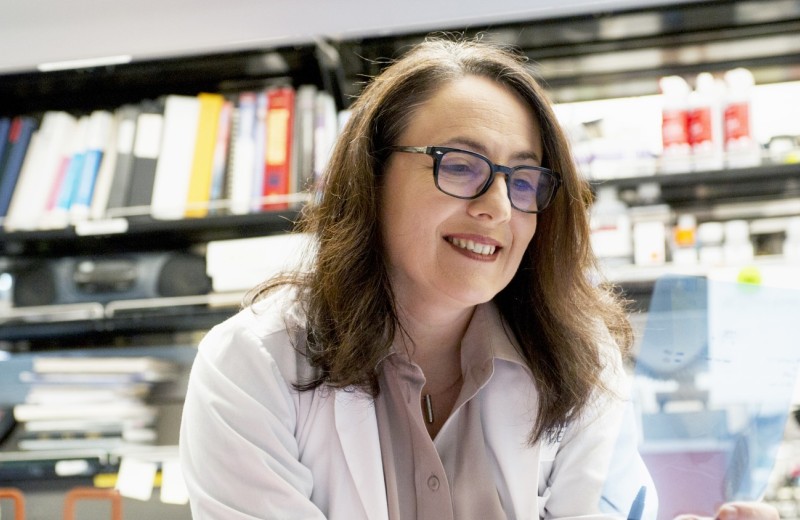Gladstone NOW: The Campaign Join Us on the Journey✕

Lennart Mucke, MD, is the founding director of the Gladstone Institute of Neurological Disease.
There’s no question we’ve reached a turning point for Alzheimer’s disease treatment.
Just a few months ago, the U.S. Food and Drug Administration approved a new drug that has shown to slow the pace of cognitive decline in early stages of the disease. This follows approval of a similar drug last year. Both of the new therapies—marketed under the trade names Kisunla and Leqembi—were designed to remove clumps of amyloid proteins that build up in the brains of people with Alzheimer’s disease.
For Lennart Mucke, MD, founding director of the Gladstone Institute of Neurological Disease, these new drugs mark an important milestone: No longer are Alzheimer’s treatments just addressing symptoms, they’re actually targeting processes that cause the disease. And as Mucke knows well, it’s been a long time coming.
He and his team were directly involved in research that made today’s amyloid-targeting approaches possible—including efforts to create and refine the experimental models used to evaluate treatments before they could reach patients, a critical step in drug development. While he’s excited about the new therapies, which have yielded promising results thus far, he believes a lot more work is needed to overcome this formidable condition.
As Gladstone Institutes commemorates World Alzheimer’s Month, we spoke with Mucke about what’s next for Alzheimer’s research, the role of nonprofit research organizations in developing new therapies, and why he has more hope than ever for a future where neurodegenerative diseases are fully treatable—and even preventable.
We now have two promising Alzheimer’s drugs on the market. But you say there’s still much work to be done. Why is that?
Excitement about these new drugs is definitely warranted. The clinical trials suggest it’s possible to change the course of Alzheimer’s for the better, even when it has already caused some memory loss. This is encouraging. We know that the brain’s extraordinary plasticity allows it to recover from, or outmaneuver, many types of injuries, so there’s even a chance of additional benefits from prolonged treatment.
But as meaningful as this is, we’re far from finished. These treatments aren’t perfect. They’re costly and need to be given by IV infusion. In addition, patients must be closely monitored for possible side effects. All of this limits patient access to the treatments. Many efforts are underway to further reduce the risk of side effects and develop forms of these drugs that patients could administer at home, much like people do for diabetes and other chronic conditions.
What other approaches are in development, and why is it important to have more treatment options?
Alzheimer’s is a complicated disease and, to achieve the best outcomes for patients, we will most likely require a combination of therapies targeting multiple disease-causing mechanisms. Different interventions may also be needed for different patients, depending on why they developed the disease or what stage they’re in.
The good news is that drug development portfolios for Alzheimer’s are diversifying in ways that finally begin to match the complexity of the disease, giving us many more shots on goal than we had in the past. Over 160 clinical trials are currently underway, with over two thirds classified as “disease-modifying.” And discoveries are still unfolding.
For example, Gladstone scientists have made major progress in understanding APOE4, the most important genetic risk factor for Alzheimer’s disease. We’re also exploring how best to target tau, another protein that accumulates in the brains of Alzheimer’s patients. And our investigators discovered that the blood protein fibrin triggers neurodegeneration when it leaks into the brain; a potential treatment to counteract this has entered early clinical trials. My colleagues and I will continue to decode the biology of Alzheimer’s disease and identify novel treatment strategies until this scourge has been overcome.

Lennart Mucke (left) in a discussion with Eric Shao (middle) and Che-Wei Chang (right)—former members of the Mucke Lab—about how reducing brain levels of the protein tau may prevent abnormal activities of neuronal networks in Alzheimer’s disease and related conditions.
What role do research institutes such as Gladstone play in bringing new Alzheimer’s treatments to patients?
It’s important to realize that many of the big companies that typically develop new therapeutics have backed out of drug discovery for brain disorders because of the complexity of these conditions and the high risk of drug failures. As a result, the responsibility for discovering and developing new treatment strategies has shifted to nonprofit research institutions such as ours. By validating drug targets and de-risking related chemical compounds that could be used as potential therapies, it’s possible to bring big pharma and biotech back to the table in an effort to advance such valuable assets to the finish line.
While pharmaceutical companies are specialized in developing medicines that can be safely given to millions of people for many years, Gladstone’s mission is to trailblaze into high-risk areas of biomedicine and identify novel angles for the treatment of unsolved diseases. That is how true breakthroughs happen.
How are new technologies reshaping what we know about Alzheimer’s and the brain?
Over the past five years, we’ve seen an enormous acceleration in the development of enabling tools for biological studies, from large-scale analyses of molecules and cells, to gene editing, imaging technologies, and artificial intelligence. This is opening new doors for brain research and generating novel insights into Alzheimer’s and related disorders.
For instance, we’re now able to monitor and alter, in real time, the activity of neuronal networks that support important brain functions, as well as identify and block the processes that destabilize these networks in disease. Likewise, by using AI and machine learning, our investigators are discovering disease “signatures” in gene expression and in behaviors that couldn’t have been predicted from prior knowledge. These signatures can improve diagnoses and serve as useful outcome measures for therapeutic interventions.
We’re also using these leading-edge approaches to unravel how genetics shapes vulnerability and resistance to disease, which types of brain cells form the frontline of defense, and how their capabilities might be leveraged and enhanced. Together, these tools give us an even deeper understanding of Alzheimer’s and allow us to tackle great challenges in a more comprehensive way.
What do you predict the Alzheimer’s landscape will look like in 25 years?
My dream is that our discoveries and translational efforts will transform Alzheimer’s into a disease that can be effectively treated and possibly even reversed, if caught in time.
But ideally, we want to prevent the disease altogether, just like we’ve learned to prevent AIDS and complications of atherosclerosis, such as heart attacks and strokes. I believe this is possible.
To reach this goal, we’ll need better biomarkers that allow for early diagnosis. Blood biomarkers are beginning to look extremely promising in this regard. As more treatments come online that can really change the course of Alzheimer’s, this disease will become more like other preventable aging-associated conditions for which people are routinely tested—like common cancers, diabetes, and heart disease.
The reality is that Alzheimer’s is a risk for many of us. Yet, patients continue to deal with social stigma associated with the disease, which also deters many people from seeking a diagnosis or even learning if they have a genetic risk factor. As ongoing research efforts make this condition more readily detectable, treatable, and preventable, the perceived threat and stigma of the disease are likely to fade, and more and more people will be willing to get tested early and address the disease head on. We’ll see less fear surrounding Alzheimer’s and more hope, which is already justified today given the improved treatment options.
Support Discovery Science
Your gift to Gladstone will allow our researchers to pursue high-quality science, focus on disease, and train the next generation of scientific thought leaders.
Gladstone’s Scientific Highlights of 2025
Gladstone’s Scientific Highlights of 2025
From fundamental insights to translational advances, here’s how Gladstone researchers moved science forward in 2025.
Gladstone Experts Alzheimer’s Disease Autoimmune Diseases COVID-19 Neurological Disease Genomic Immunology Cardiovascular Disease Data Science and Biotechnology Infectious Disease Conklin LabScience in Seconds | The Thinking Microscope: Research Powered by an AI Brain
Science in Seconds | The Thinking Microscope: Research Powered by an AI Brain
In this video, Steve Finkbeiner and Jeremy Linsley showcase Gladstone’s groundbreaking “thinking microscope”—an AI-powered system that can design, conduct, and analyze experiments autonomously to uncover new insights into diseases like Alzheimer’s, Parkinson’s, and ALS.
Gladstone Experts ALS Alzheimer’s Disease Parkinson’s Disease Neurological Disease Finkbeiner Lab AI Big DataKaterina Akassoglou Receives Zenith Fellows Award to Advance Alzheimer’s Research
Katerina Akassoglou Receives Zenith Fellows Award to Advance Alzheimer’s Research
Akassoglou has opened doors to understanding how the blood protein fibrin is involved in Alzheimer’s and other neurodegenerative diseases.
Awards News Release Alzheimer’s Disease Center for Neurovascular Brain Immunology Akassoglou Lab




